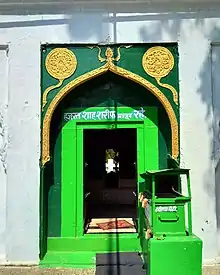Maloji Bhosale
Maloji Bhosale was a Maratha sardar (general) who served the Ahmadnagar Sultanate in Malik Ambar's army. He was the father of Shahaji and the grandfather of Chhatrapati Shivaji, the founder of the Maratha Empire.
Maloji Raje Bhosale | |
|---|---|
| Born | 1552 |
| Died | 1620 |
| Children | Shahaji, Sharifji |
| Parent | Babaji Bhosale (father) |
Early life
Maloji was born in 1552 to Babaji Bhosale (d. 1597), a patil (chief) of the Hingni Berdi and Devalgaon villages around Pune.[1][2] Maloji had a younger brother, Vithoji.
Military career under the Jadhavs of Sindkhed
Maloji and his brother Vithoji migrated away from Pune, and initially served as petty horsemen under the Jadhavs of Sindkhed.[3] The Jadhavs provided military service to the Ahmednagar Sultanate. Maloji married Uma Bai (also known as Dipa Bai), the sister of Jagpalrao Nimbalkar, who was the deshmukh of Phaltan

According to Shivabharata, composed by Shivaji's court poet Paramananda, Maloji's wife Umabai prayed to the Sufi Pir Shah Sharif of Ahmadnagar to bless her with a son. She gave birth to two sons, who were named Shahaji and Sharifji after the Pir.[4][5]
According to one account, during a Holi function, the Jadhav chief Lakhuji remarked, in a lighter vein, that his daughter Jijabai and Shahaji would make a fine couple. Maloji took Lakhuji's remark seriously, and announced publicly that his son was engaged to Lakhuji's daughter. This irked Lakhuji, who considered Maloji to be a non-noble Shiledar.[6] He dismissed Maloji from his services. Later, Nimbalkar's influence and the rising status of the Bhosale family helped Shahaji marry Jijabai.
Ahmednagar Sultanate service
According to one account, Maloji and Vithoji once found a treasure while tilling a field and became rich.[7] They raised a small troop, and briefly harassed Lakhuji.
In 1577, like the Nimbalkars, the two brothers joined the service of the Ahmednagar Sultanate, under Murtaza Nizam Shah I. Maloji became a trusted aide of Malik Amber, who rose to the Prime Ministership of the Ahmadnagar Sultanate.[8] Maloji's cousins, the Ghorpades of Mudhol, also became successful noblemen, serving the rival Sultanate of Bijapur.[9]
Maloji rose rapidly in the service of Malik Ambar, fighting against the rival Deccan Sultanates and the Mughals. He and his brother were granted the control of three parganas (administrative units): Elur (Verul), Derhadi and Kannarad (including Jategau and Vakadi), beside several small towns and villages.[6] In 1595 or 1599, Maloji was given the title of raja by Bahadur Nizam Shah, the ruler of the Ahmednagar Sultanate.[10] On the recommendation of Malik Ambar, he was given the jagir of Pune and Supe parganas, along with the control of the Shivneri and Chakan forts. Maloji carried out the restoration of the Grishneshwar temple near Verul, and also constructed a large tank at the Shambhu Mahadev temple in Shikhar Shingnapur.[11]
Death
Maloji died during a battle against the Bijapur Sultanate, at Indapur. One account puts his year of death as 1606, and mentions that his son Shahaji, five-years old at the time, was raised by his brother Vithoji.[6] Other accounts put the year of his death as 1620[12] or 1622.[9] After his death, his jagir was transferred to his son Shahaji.
References
- Salma Ahmed Farooqui (2011). A Comprehensive History of Medieval India: From Twelfth to the Mid-Eighteenth Century. Dorling Kindersley India. pp. 314–. ISBN 978-81-317-3202-1.
- V. B. Kulkarni (1963). Shivaji: The Portrait of a Patriot. Orient Longman. p. 27.
- Satish Chandra (2005). Medieval India: From Sultanat to the Mughals. Har-Anand. p. 316. ISBN 978-81-241-1066-9. Retrieved 8 October 2012.
- G. H. Khare (1974). Studies in Indology and Medieval History. Joshi & Lokhande. p. 176.
- James W. Laine (2000). "A Question of Maharashtrian Identity: Hindu Self-definition in the Tales of Shivaji". In Meera Kosambi (ed.). Intersections: Socio-cultural Trends in Maharashtra. Orient Blackswan. p. 62. ISBN 9788125018780. Retrieved 15 November 2022.
- Chintaman Vinayak Vaidya (1931). Shivaji: the founder of Maratha Swaraj. C. V. Vaidya. pp. 10–15. Retrieved 8 October 2012.
- Charles Augustus Kincaid; Dattatraya Balavanta Pārasanisa (1968). A History of the Maratha People: From the earliest times to the death of Shivaji. S. Chand. p. 114. Retrieved 8 October 2012.
- Farooqui Salma Ahmed; Salma Ahmed Farooqui (2011). A Comprehensive History of Medieval India: From Twelfth to the Mid-Eighteenth Century. Pearson Education India. p. 314. ISBN 978-81-317-3202-1. Retrieved 8 October 2012.
- Stewart Gordon (16 September 1993). The Marathas 1600-1818. Cambridge University Press. pp. 41–44. ISBN 978-0-521-26883-7. Retrieved 8 October 2012.
- Joseph G. Da Cunha (1900). Origin of Bombay. Bombay, Society's library; [etc., etc.]
- Govind Sakharam Sardesai (1957). New History of the Marathas: Shivaji and his line (1600-1707). Phoenix Publications. p. 58. ISBN 9788121500654. Retrieved 8 October 2012.
- Richard M. Eaton (17 November 2005). A Social History of the Deccan, 1300-1761: Eight Indian Lives. Cambridge University Press. pp. 178–. ISBN 978-0-521-25484-7. Retrieved 8 October 2012.
